radiator AUDI S3 2009 Owners Manual
[x] Cancel search | Manufacturer: AUDI, Model Year: 2009, Model line: S3, Model: AUDI S3 2009Pages: 324, PDF Size: 76.02 MB
Page 12 of 324
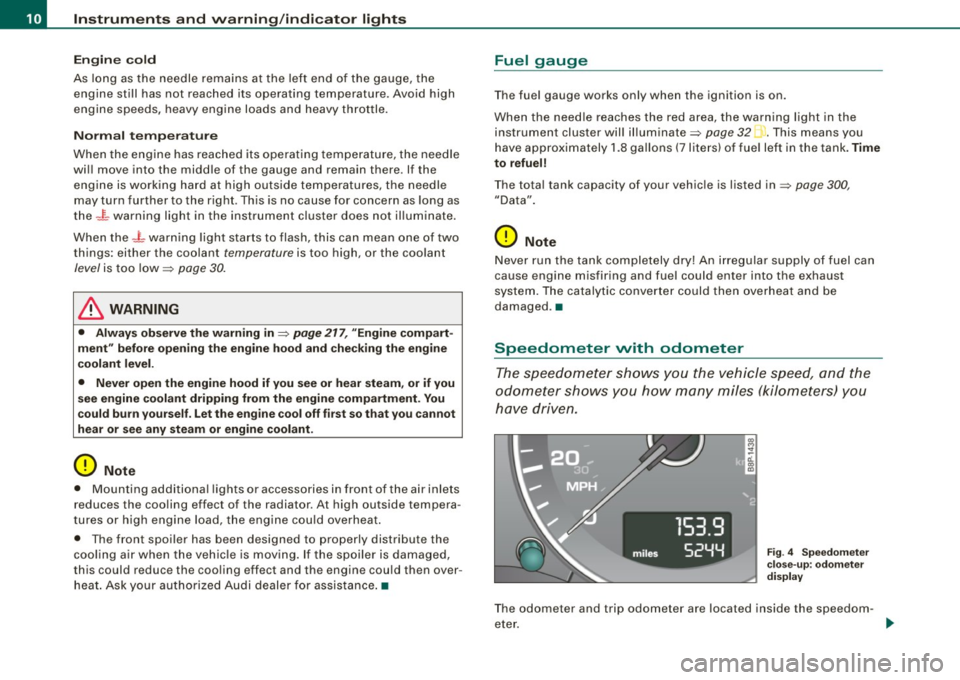
Instruments and warning/indicator lights
Engine cold
As long as the needle remains at the left end of the gauge, the
engine still has not reached its operating temperature . Avoid high
engine speeds, heavy engine loads and heavy throttle.
Normal temperature
When the engine has reached its operating temperature, the needle
will move into the middle of the gauge and remain there. If the engine is working hard at high outside temperatures, the needle
may turn further to the right. This is no cause for concern as long as
the
_ f_ warning light in the instrument cluster does not illuminate.
When the
-L warning light starts to flash, this can mean one of two
things: either the coolant
temperature is too high, or the coolant
level is too low=> page 30.
& WARNING
• Always observe the warning in => page 217, "Engine compart
ment" before opening the engine hood and checking the engine
coolant level.
• Never open the engine hood if you see or hear steam, or if you
see engine coolant dripping from the engine compartment. You
could burn yourself. Let the engine cool off first so that you cannot
hear or see any steam or engine coolant.
0 Note
• Mounting additional lights or accessories in front of the air inlets
reduces the cooling effect of the radiator . At high outside tempera
tures or high engine load, the engine could overheat.
• The front spoiler has been designed to properly distribute the
cooling air when the vehicle is moving. If the spoiler is damaged,
this could reduce the cooling effect and the engine could then over
heat. Ask your authorized Audi dealer for assistance. •
Fuel gauge
The fuel gauge works only when the ignition is on.
When the needle reaches the red area, the warning light in the
instrument cluster will illuminate=>
page 32 I). This means you
have approximately 1.8 gallons (7 liters) of fuel left in the tank.
Time
to refuel!
The total tank capacity of your vehicle is listed in=> page 300,
"Data".
0 Note
Never run the tank completely dry! An irregular supply of fuel can
cause engine misfiring and fuel could enter into the exhaust
system. The catalytic converter could then overheat and be
damaged .•
Speedometer with odometer
The speedometer shows you the vehicle speed, and the
odometer shows you how many miles (kilometers) you
have driven.
Fig. 4 Speedometer
close-up : odometer
display
The odometer and trip odometer are located inside the speedom
eter.
Page 33 of 324
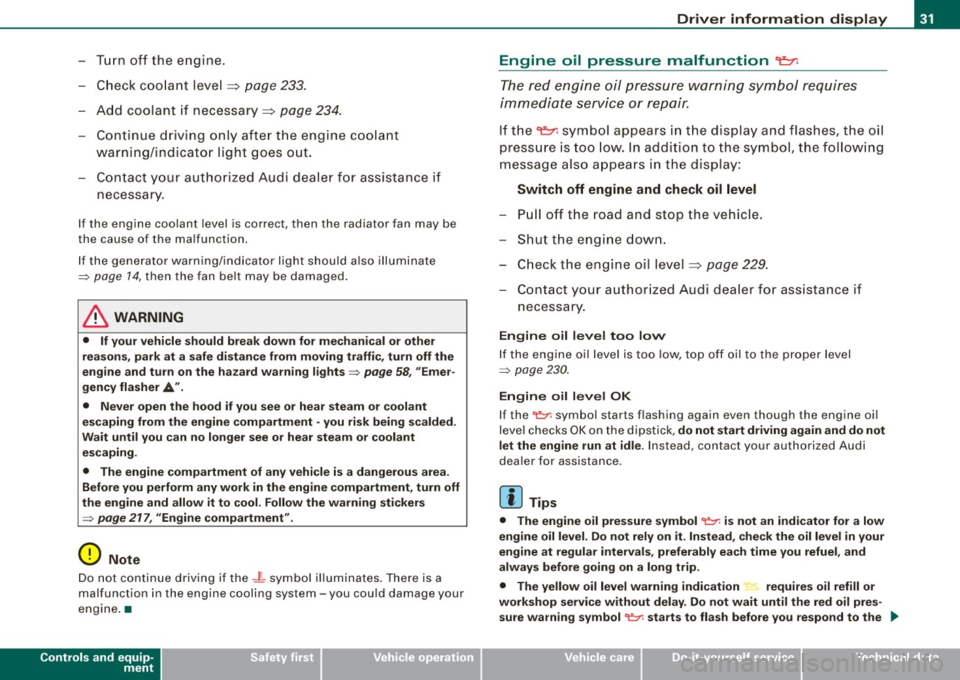
-Turn off the engine.
- Check coolant level => page
233 .
-Add coolant if necessary => page 234 .
-Continue driving only after the engine coolant
warning/indicator light goes out.
- Contact your authorized Audi dealer for assistance if
necessary.
If the engine coolant level is correct, then the radiator fan may be
the cause of the malfunction.
If the generator warning/indicator light should also illuminate
=> page 14, then the fan belt may be damaged .
& WARNING
• If your vehicle should break down for mechanical or other
reasons, park at a safe distance from moving traffic, turn off the
engine and turn on the hazard warning lights
=> page 58, "Emer
gency flasher
A".
• Never open the hood if you see or hear steam or coolant
escaping from the engine compartment -you risk being scalded.
Wait until you can no longer see or hear steam or coolant
escaping.
• The engine compartment of any vehicle is a dangerous area.
Before you perform any work in the engine compartment, turn off
the engine and allow it to cool . Follow the warning stickers
=> page 217, "Engine compartment" .
0 Note
Do not continue driving if the -IL symbol illuminates. There is a
malfunction in the engine cooling system -you could damage your
engine. •
Controls and equip
ment
Driver information display
Engine oil pressure malfunction 'l=;:f.
The red engine oil pressure warning symbol requires
immediate service or repair.
If the 'l=::7-: symbol appears in the display and flashes, the oil
pressure is too low. In addition to the symbol, the following
message also appears in the display:
Switch off engine and check oil level
-Pull off the road and stop the vehicle.
Shut the engine down.
Check the engine oil level=> page
229.
Contact your authorized Audi dealer for assistance if
necessary.
Engine oil level too low
If the engine oil level is too low, top off oil to the proper level
=> page 230.
Engine oil level OK
If the ~ symbol star ts flashing again even though the engine oil
level checks OK on the dipstick,
do not start driving again and do not
let the engine run at idle .
Instead, contact your authorized Audi
dealer for assistance.
[ i] Tips
• The engine oil pressure symbol ~ is not an indicator for a low
engine oil level. Do not rely on it. Instead, check the oil level in your
engine at regular intervals, preferably each time you refuel, and
always before going on a long trip.
• The yellow oil level warning indication requires oil refill or
workshop service without delay. Do not wait until the red oil pres
sure warning symbol
~ starts to flash before you respond to the ...
I • •
Page 111 of 324
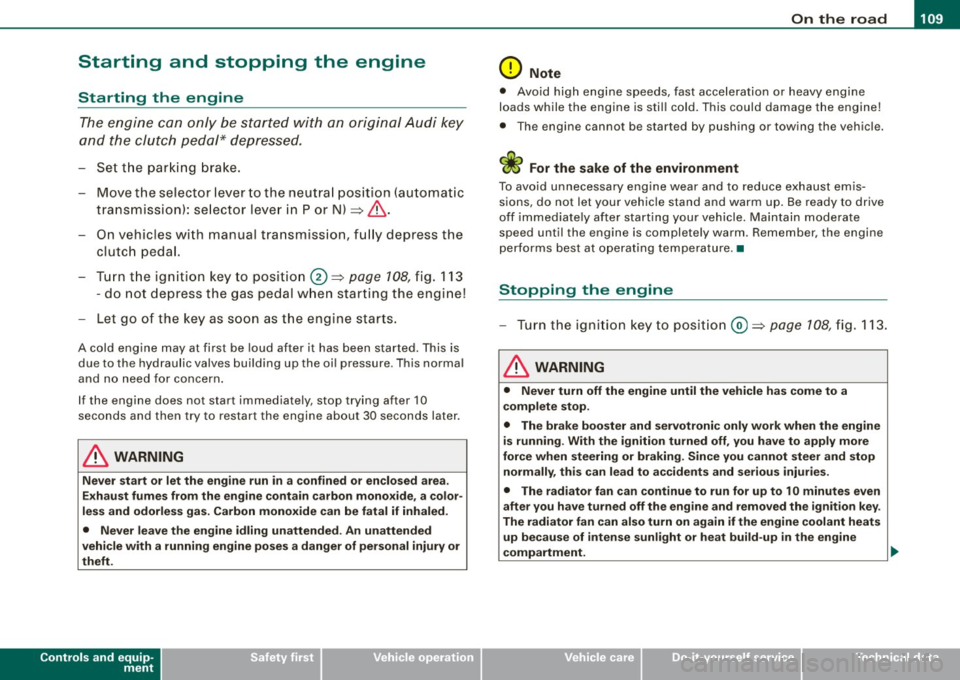
___________________________________________________ O _n_ t_h _ e_ r_ o _ a_ d __ lfflll
Starting and stopping the engine
Starting the engine
The engine can only be started with on original Audi key
and the clutch pedal* depressed.
- Set the parking brake.
Move the selector lever to the neutral position (automatic
transmission): selector lever in P or N) =>
&.
- On vehicles with manual transmission, fully depress the
clutch pedal.
- Turn the ignition key to position@=>
page 108, fig. 113
- do not depress the gas pedal when starting the engine!
- Let go of the key as soon as the engine starts.
A cold engine may at first be loud after it has been started. This is
due to the hydraulic valves building up the oil pressure . This normal
and no need for concern.
If the engine does not star t immediately, stop trying after 10
seconds and then try to restart the engine about 30 seconds later.
& WARNING
Never start or let the engine run in a confined or enclosed area.
Exhaust fumes from the engine contain carbon monoxide, a color
less and odorless gas. Carbon monoxide can be fatal if inhaled .
• Never leave the engine idling unattended. An unattended
vehicle with a running engine poses a danger of personal injury or
theft.
Controls and equip
ment
0 Note
• Avoid high engine speeds, fast acceleration or heavy engine
loads while the engine is still cold. This could damage the engine!
• The engine cannot be started by pushing o r towing the vehicle.
~ For the sake of the environment
To avoid unnecessary engine wear and to reduce exhaust emis
sions, do not let your vehicle stand and warm up. Be ready to drive
off immediately after starting your vehicle. Maintain moderate
speed until the engine is completely warm. Remember, the engine
performs best at operating temperature. •
Stopping the engine
-Turn the ignition key to position@=> page 108 , fig. 113.
& WARNING
• Never turn off the engine until the vehicle has come to a
complete stop.
• The brake booster and servotronic only work when the engine
is running . With the ignition turned off, you have to apply more
force when steering or braking. Since you cannot steer and stop
normally, this can lead to accidents and serious injuries.
• The radiator fan can continue to run for up to 10 minutes even
after you have turned off the engine and removed the ignition key.
The radiator fan can also turn on again if the engine coolant heats
up because of intense sunlight or heat build-up in the engine
compartment. .,
I • •
Page 220 of 324

___ C_ le_ a _ n_i_n ~g _ a_ n_ d __ p_r _o _t _e _c_ t_ i_o _n ___________________________________________ _
& WARNING (continued )
• Before reaching into the front plenum panel, always remove the
ignition key . Otherwise, the windshield wiper system could unin
tentionally be switched on , possibly causing personal in jury from
the moving wiper linkage .
• Never reach into the area around or touch the radiator fan . The
auxiliary fan is temperature controlled and can switch on suddenly
- even when the ignition is off.
• Do not wash, wax or dry the engine with the engine running .
Moving or hot parts could injure you .
• Do not clean the underside of the chassis , fenders , wheel
covers, or other hard to reach parts without protecting your hands
and arms. You may cut yourself on sharp-edged metal parts.
• Always read and heed all WARNINGS and other information
~ poge206. a
Page 227 of 324
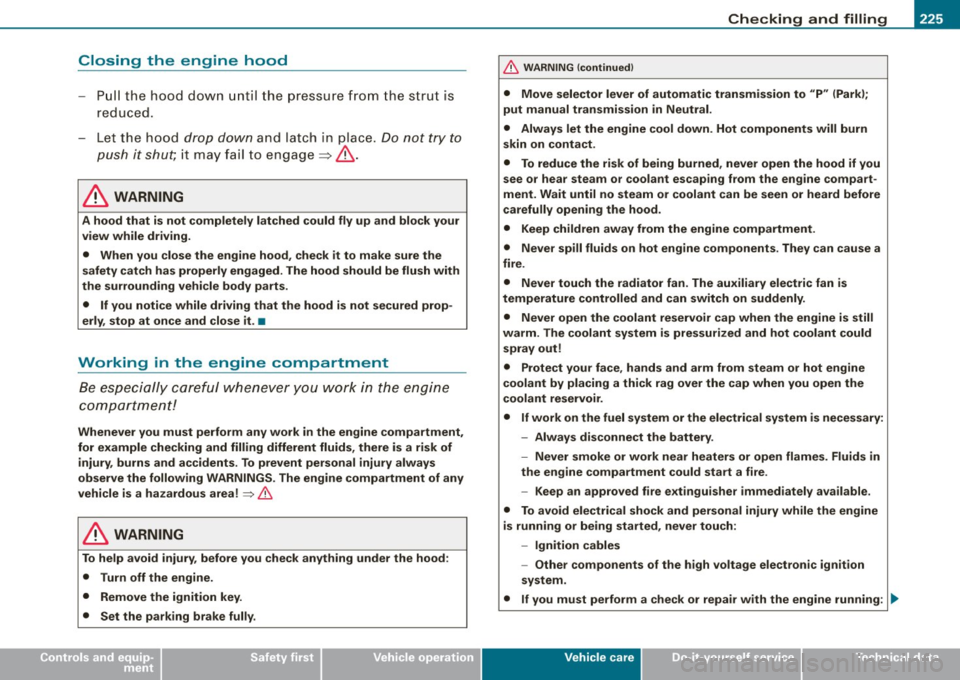
Checking and filling -
--------------~-
•
Closing the engine hood
-Pull the hood dow n until the pressure fro m t he s trut is
r edu ce d .
- Let the hood
drop dow n and latch in p lace . Do not try to
pus h it shut ;
it ma y fail to enga ge => & .
& WARNING
A hood that is not completely latched could fly up and block your
view while driving.
• When you close the engine hood, check it to make sure the
safety catch has properly engaged. The hood should be flush with
the surrounding vehicle body parts .
• If you notice while driving that the hood is not secured prop
erly , stop at on ce and close it. •
Working in the engine compartment
B e e speci ally ca reful wh ene ver you work in th e e ng in e
co mpartmen t!
Whenever you must perform any work in the engine compartment ,
for example checking and filling different fluids , there is a ri sk of
injury , burns and accidents . To prevent personal injury always
observe the following WARNINGS . The engine compartment of any
vehicle is a hazardous area!
~ &
& WARNING
To help avoid injury , before you check anything under the hood :
• Turn off the engine.
• Remove the ignition key .
• Set the parking brake fully .
& WARNING (continued )
• Move selector lever of automatic transmission to "P" (Park) ;
put manual transmission in Neutral .
• Always let the engine cool down . Hot components will burn
skin on contact.
• To reduce the risk of being burned , never open the hood if you
see or hear steam or coolant escaping from the engine compart
ment . Wait until no steam or coolant can be seen or heard before
carefully opening the hood .
• Keep children away from the engine compartment .
• Never spill fluids on hot engine components . They can cause a
fire.
• Never touch the radiator fan. The auxiliary electric fan is
temperature controlled and can switch on suddenly.
• Never open the coolant reservoir cap when the engine is still
warm . The coolant system is pressurized and hot coolant could
spray out!
• Protect your face , hands and arm from steam or hot engine
coolant by placing a thick rag over the cap when you open the
coolant reservoir .
• If work on the fuel system or the electri cal system is necessary :
- Always disconnect the battery .
- Never smoke or work near heaters or open flames . Fluids in
the engine compartment could start a fire .
- Keep an approved fire extinguisher immediately available.
• To avoid electrical shock and personal injury while the engine
is running or being started , never touch :
- Ignition cables
- Other components of the high voltage electronic ignition
system .
• If you must perform a check or repair with the engine running : ..,
Vehicle care
I t •
Page 228 of 324
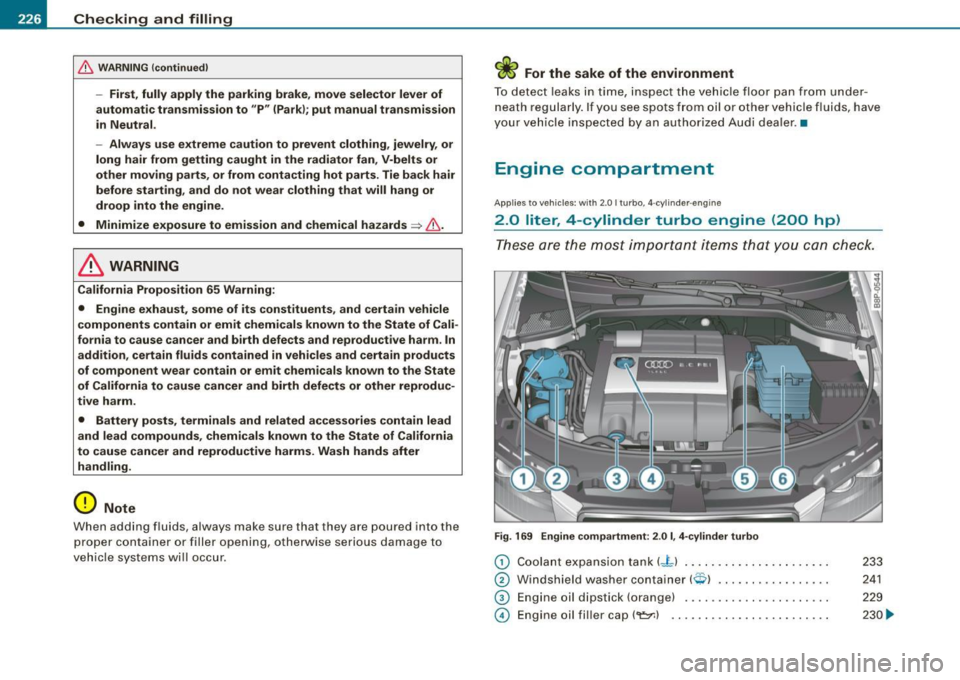
___ C_ h_ e _ c_k _in--= g'-- a_n _d_ f_il _li _n --=g==-- --------------------------------------------
& WARNING (continued )
-First, fully apply the park ing brake, move selector lever of
automatic transmission to "P " (Park ); put manual transmission
in Neutral.
- Alway s use extreme c aution to prevent clothing , jewel ry , or
long hair from gettin g caught in the radiator fan , V-belts or
other moving parts , or from contacting hot parts. Tie back hair
before starting , and do not wear clothing that will hang or
droop into the engine .
• Minimize exposure to emission and chemi cal hazard s
=> &.
& WARNING
Californ ia Proposition 65 Warning :
• Engine exhaust , some of its constituents , and certa in vehicle
component s contain or emit chemical s known to the State of Cali
fornia to cause cancer and birth defe cts and reproductive h arm . In
addition, certain fluid s contained in vehicles and certain products
of component wear contain or emit chem icals known to the State
of California to cause cancer and birth defects or other reproduc
tive harm.
• Battery posts , terminals and related ac cessories contain lead
and lead compounds , chem icals known to the State of California
to cause cancer and reproductive harms. Wash hand s after
handling .
0 Note
When adding fluids , always make sure that the y are pou red into the
proper conta iner or filler opening, otherw ise serious damage to
vehicle systems will occur .
<£' For the sake of the environment
To detect leaks in t ime , inspect the veh icle floor pan from unde r
neath regularly. If you see spots from oil or other veh ic le fluids, have
you r ve hicle i nsp ected by a n authori zed Audi dealer .•
Engine compartment
A pp lies t o ve hicles: wit h 2.0 I tur bo, 4-cy linder •engi ne
2 .0 liter , 4 -cylinder turbo engine (200 hp )
These a re th e mo st imp ortan t items that you can check.
F ig . 169 Engine comp artment : 2.0 I , 4 -cylinder turbo
G) Coolant expans ion tank ( - f- ) ... .. .... ... .... ..... .
0 Windshie ld washe r con tainer ( Q ) .. ..... .... ..... .
© Engi ne oil dipstick (orange) .............. ... .... .
© Engin e oil filler cap ('e:r.) ............ ..... .... .. .
233
241
229
2 30 ..,,
Page 235 of 324
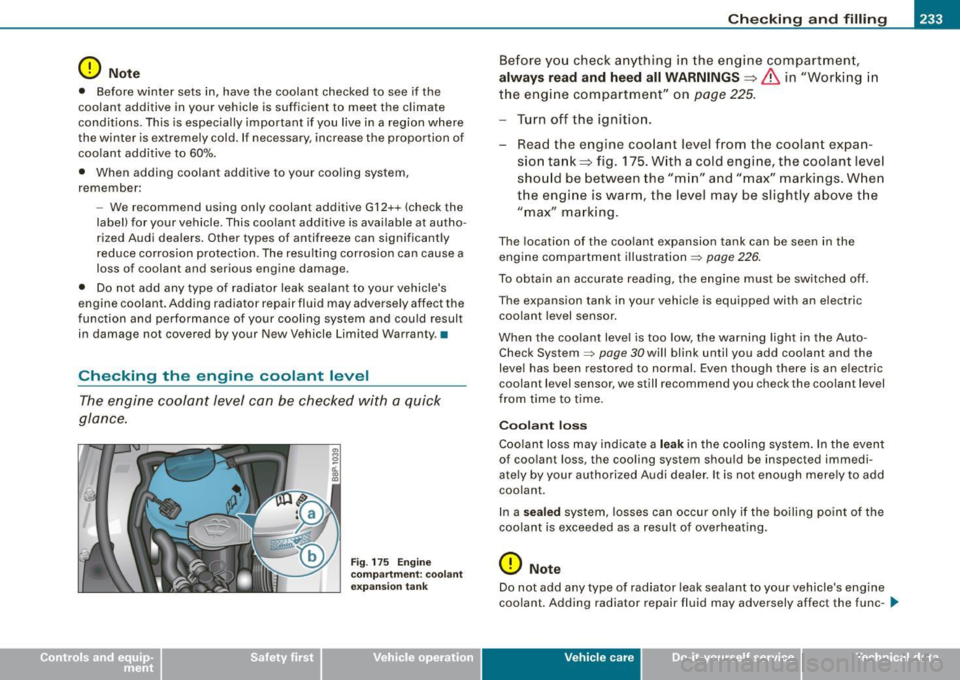
Checking and filling -
---------------------=----"=---------
0 Note
• Before winter sets in, have the coolant checked to see if the
coolant additive in your vehicle is sufficient to meet the climate
conditions. This is especially important if you live in a region where
the winter is extremely cold. If necessary, increase the proportion of
coolant additive to 60%.
• When adding coolant additive to your cooling system,
remember:
-We recommend using only coolant additive G12+ + (check the
label) for your vehicle. This coolant additive is available at autho
rized Audi dealers. Other types of antifreeze can significantly
reduce corrosion protection . The resulting corrosion can cause a
loss of coolant and serious engine damage .
• Do not add any type of radiator leak sealant to your vehicle's
engine coolant. Adding radiator repair fluid may adversely affect the
function and performance of your cooling system and could result
in damage not covered by your New Vehicle Limited Warranty .•
Checking the engine coolant level
The engine coolant level can be checked with a quick
glance.
Fig . 175 Engine
compartment : coolant
expansion tank
Before you check anything in the engine compartment,
always read and heed all WARNINGS==> & in "Working in
the engine compartment" on
page 225.
Turn off the ignition.
Read the engine coolant level from the coolant expan
sion tank==> fig. 175. With a cold engine, the coolant level
should be between the "min" and "max" markings. When
the engine is warm, the level may be slightly above the
" max" marking.
The location of the coolant expansion tank can be seen in the
engine compartment illustration=>
page 226.
To obtain an accurate reading, the engine must be switched off.
The expansion tank in your vehicle is equipped with an electric
coolant level sensor.
When the coolant level is too low, the warning light in the Auto
Check System =>
page 30will blink until you add coolant and the
level has been restored to normal. Even though there is an electric
coolant level sensor, we still recommend you check the coolant level
from time to time.
Coolant loss
Coolant loss may indicate a leak in the cooling system. In the event
of coolant loss, the cooling system should be inspected immedi
ately by your authorized Audi dealer. It is not enough merely to add
coolant.
In a
sealed system, losses can occur only if the boiling point of the
coolant is exceeded as a result of overheating.
0 Note
Do not add any type of radiator leak sealant to your vehicle's engine
coolant. Adding radiator repair fluid may adversely affect the tune- _..
Vehicle care I I Technical data
Page 237 of 324
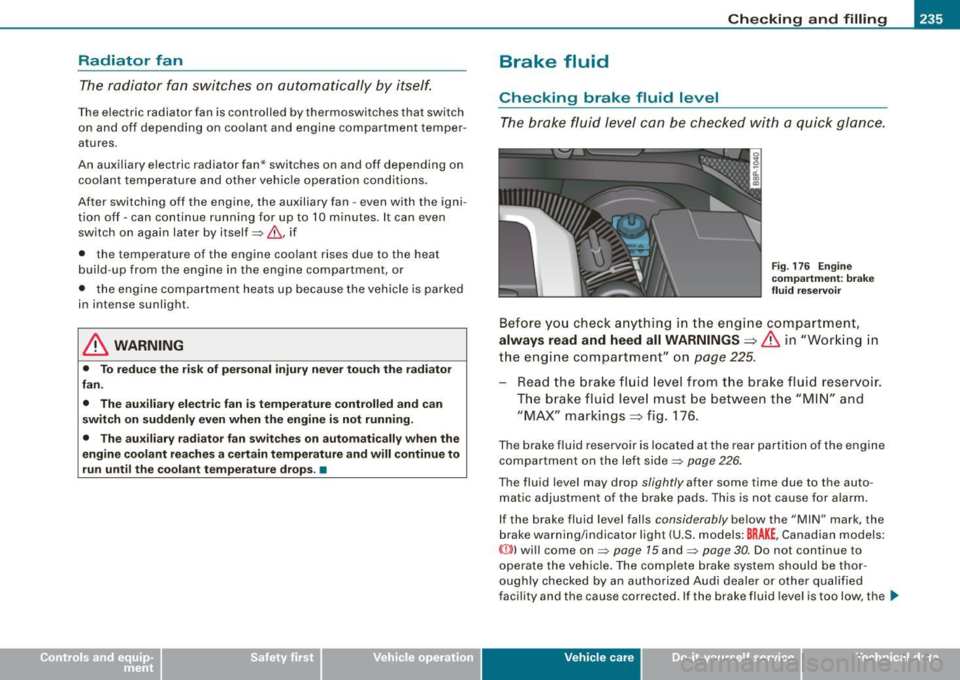
Checking and filling -
---------------------=----"=---------
Radiator fan
The radiator fa n switches on au toma tically by i tself.
T he e lectric radiator fan is control led bythermoswitches that switch
on and off depending on coolan t and engine compar tm ent temper
atures .
An auxiliary e lectric radiator fan * switches on and off depending on
coolant temperature and other vehicle operation conditions.
After switching off the engine , the auxiliary fan -even with the igni
tio n off -ca n co ntinue runni ng for u p to 10 minutes. It can even
switch on again later by itself=>&, if
• the temperat ure of the engine coolant rises due to the heat
build -up from the engine in the engine compartment, or
• t he engine co mpart men t heats up because the vehicle is parked
in intense sunlight.
& WARNING
• To reduce the risk of personal injury never tou ch the r ad iator
fan .
• The auxiliary electric fan is temperature controlled and can
switch on suddenly even when the engine i s not running .
• The auxiliary radiator fan switches on automatically when the
engine cool ant reache s a certain temperature and will continue to
run until the coolant temperature drop s. •
Brake fluid
Checking brake fluid level
The bra ke flu id l evel can be che cke d wi th a q uick gla nce.
Fig . 17 6 Engine
c o mpartment : brake
fluid re ser vo ir
Be fore yo u check anythin g in the e ng ine compar tm ent,
always read and heed all WARNINGS=> & in "Working in
t h e eng ine compartment" on
page 225.
Read t he brake fl uid lev el from t he brake flui d res ervoir .
T he b rak e fluid l eve l must b e between the
"MI N" and
"M AX" markings => fig. 176.
The brake f luid reservoir is located at the rear pa rtit ion of the engine
compartment on the left side=> page 226.
T he fluid leve l may drop slightly after some time due to the auto
ma tic adjustment o f the brake pads. Th is is not cause for alarm .
I f the brake flu id leve l falls considerably below the "MIN" mark, the
brake warning/indicator light (U.S . models :
BRAKE, Canadian models:
ID ) will come on=> page 15 and=> page 30. Do not continue to
operate the vehic le . The complete brake system should be thor
oughly checked by an au thorized Audi dealer or other qualified
facility and the cause corrected. If the brake fluid leve l is too low, the .,,_
Vehicle care I I irechnical data
Page 307 of 324
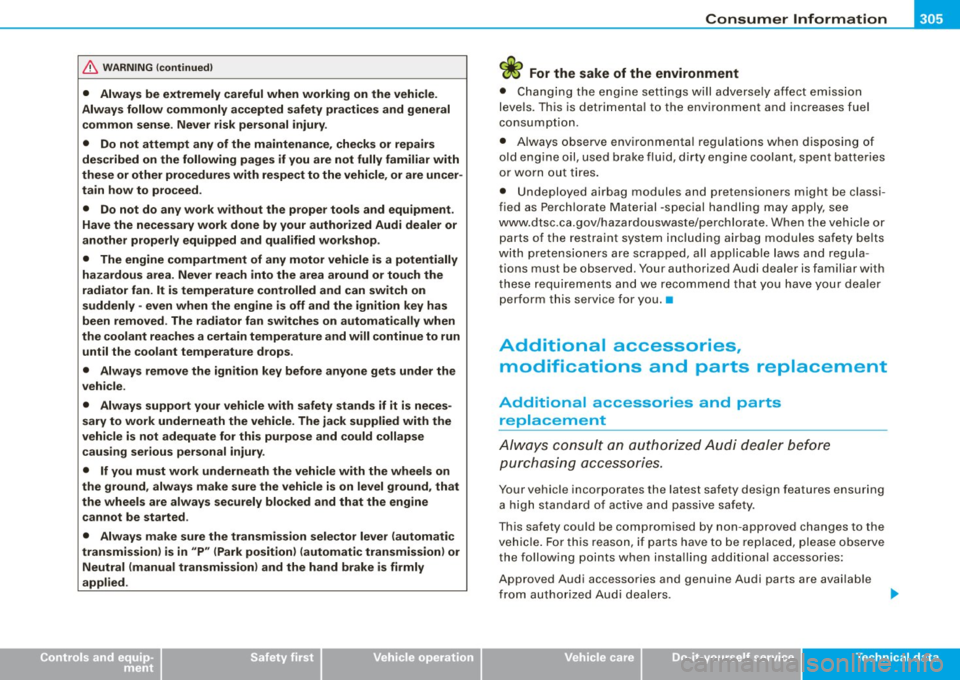
------------------------------------------------=C :..:o=. n :..:..: s:..:u::.: m:...:..:. e::.:.. r..:l~ n .:..:f:..: o:.: r :..:m~ a::.:. ti:.:o::. n:....:__ _11111
& WA RNIN G (continu ed )
• Alway s be extremely careful when working on the v ehicle .
Alway s follo w commonly accepted safety pr actice s and general
c ommon sen se . Never risk per sonal inju ry .
• Do n ot attempt any of the m aint enance , check s or rep air s
de scribed on the following pages if you are not fully famili ar with
the se or othe r procedures with respect to the vehicle , or are u ncer
t a in ho w to pro ceed .
• Do not do any work w ithout the proper tool s and equipment .
Have the necessary work done by your authorized Audi de aler or
anothe r properly equipped and qual ified work shop .
• The engine compartment of any motor vehicle i s a potentially
h azardou s are a. Ne ver rea ch into the are a around or touch the
radiator fan. It is te mperature controlled and can switch on
s uddenly · even when the engine is off and the ignition key has
been remo ved . The radi ator fan switches on automat icall y when
the coolant reaches a certain temperature and will continue to run
until the coolant t emper ature drops .
• Alway s remo ve the ignition key befor e anyone get s under the
v ehi cle .
• Alway s support your vehicle with safety sta nd s if it i s nece s
sary to work underneath the vehicle . The ja ck supplied with the
vehi cle is not adequate for this p urpo se a nd co uld coll apse
c au sing ser iou s person al in jur y.
• If you m ust w ork under neath the vehi cle with the wheel s on
the ground , alway s make sure the vehicle is on lev el ground , that
the wheels are alway s secu rel y blocked and that the engine
c annot be started .
• Alway s make sure the t ran sm iss ion selector lever (automat ic
tran smi ssion ) is in "P " (Park position ) (automati c transmis sion) or
Neutr al ( ma nual transmission ) and the h and brake i s firmly
appli ed .
Controls and equip ment Safety first Vehicle operation
<£' For the sake of the environment
•
Changing the engine settings will adverse ly affect em ission
levels. This is detrimental to the environment and increases fuel
consu mption.
• Always observe environmenta l regulations when disposing of
old engine oil, used brake fluid, d irty engine coolant, spent batteries
or worn out tires .
• Undeployed airbag modules and pretensioners might be classi
fied as Perch lorate Material -special handling may apply, see
www.dtsc.ca.gov/hazardouswaste/perchlo rate. When the vehicle or
parts of the restraint system including airbag modules safety be lts
with pretensioners are scrapped, a ll applicable laws and regu la
tions must be observed. Your authorized Audi dealer is familiar with
these requirements and we recommend that you have your dea ler
perform this service for you. •
Additional accessories,
modifications and parts replacement
Additional accessories and parts
replacement
Al ways consult an authorized Au di de aler befo re
purchasing accessories.
Your vehicle incorporates the latest safety design features ensuring
a high standard of act ive and passive sa fety.
This safety could be compromised by non -approved changes to the
vehic le . Fo r th is reason, if par ts have t o be re p laced, please observe
the fo llowing points when insta lling additional accessories:
Approved Audi accessories and genuine Audi parts are available
from autho rized Audi dealers . .,_
Vehicle care Do-it-yourself service Tec hn ica l da ta
Page 314 of 324
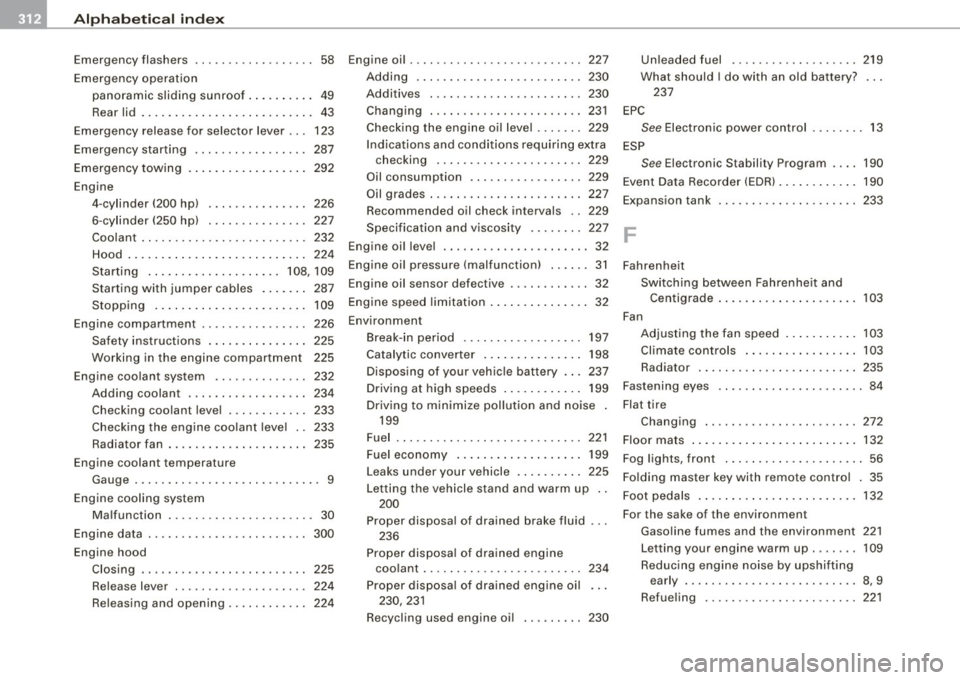
-Al
phab eti ca l ind ex
_.:_.__ ____ _...::.:...::..;.:___ ________________ _
Emergency flashers . . . . . . . . . . . . . . . . . . 58
Eme rgency operation
panoramic sliding sunroof . .... ..... 49
Rear lid . .... ... .. .... .... ...... .. 43
Emergency release for selector lever . . . 123
Emergency starting . . . . . . . . . . . . . . . . . 287
Emergency towing . . . . . . . . . . . . . . . . . . 292
Engine 4-cylinder (200 hp) ..... ... .... ... 226
6 -cylinder (250 hp) ............... 227
Coolant .......... .... ....... .... 232
Hood .... ... .. ...... .... ... .... . 224
Starting .... .... .... .... .... 108, 109
Starting with jumper cables ...... . 287
Stopping ... .... .... .... ........ 109
E . ngine compartment . .... .... .... .. .
Safety instructions ...... .... .... .
226
225
Working in the engine compar tment 225
Engine coolant system .............. 232
Adding coolant .... .... .......... 234
Checking coolant level .... .... .... 233
Checking the engine coolant leve l .. 233
Radiator fan . . . . . . . . . . . . . . . . . . . . . 235
Engine coolant temperature
Gauge .............. .............. 9
Engine cooling system
Malfunction ...... .... ....... .... . 30
E . d ngine ata ...... .... ........... .. . 300
Engine hood Closing ......................... 225
Release lever . ............... .... 224
R I . d . e easing an opening .... ... ... .. 224 Engine
oil .... ...... ........ ... .... . 227
Adding ...... ... .. .... .... ...... 230
Additives ....................... 230
Changing .. ............. ........ 231
Check ing the engine oil level .... ... 229
Indications and conditions requiring extra checking .......... ...... ...... 229
Oil consumption ................. 229
Oil grades . .... ...... ... .. .... ... 227
Recommended oil check intervals .. 229
Specification and viscosity ........ 227
Engine oil level ... ..... .. ...... ...... 32
Engine oil pressure (malfunction) ... .. . 31
Engine oil sensor defective ............ 32
Engine speed limitation .. .... .... .... . 32
Environment
B k. . d
rea -in peno .... .... .... .... . . 197
Catalytic converter . . . . . . . . . . . . . . . 198
Disposing of your vehic le battery ... 237
Driving at high speeds . . . . . . . . . . . . 199
Driving to minimize pollution and noise .
199
Fuel ............................ 221
Fuel economy . . . . . . . . . . . . . . . . . . . 199
Leaks under your vehicle . .... ..... 225
Letting the vehicle stand and warm up ..
200
Proper disposal of drained brake fluid
236
Proper disposa l of
di ra ined engine
coo lant .. .... ... .... .... .... ... 234
Proper disposa l of drained engine oil
230,231
Recycling used engine oil .. .... ... 230 Unleaded fuel
...... ... .. ... .... . 219
What should I do with an old battery?
237
EPC
See Electronic power control . . . . . . . . 13
ESP
See Electronic Stability Program .... 190
Event Data Recorder (EDR) ... .... .... . 190
Expans ion tank 233
F
Fahrenheit
Switching between Fahrenheit and Centigrade . .... .. ... ... .... .... 103
Fan Adjusting the fan speed .. .... .. .. . 103
Cl imate controls ...... ...... .... . 103
Radiator .... .... .... ... .. .... .. . 235
Fastening eyes ... ........ .... .... ... 84
Flat tire Changing ....................... 272
Floor mats . ....... ..... ... .... .... . 132
Fog lights, front ...... .... ... ... ... .. 56
Folding master key with remote control . 35
Foot pedals . ... .. .... .... ...... .... 132
For the sake of the environment
Gasoline fumes and the environment 221
Letting your engine warm up . ..... . 109
Reducing engine noise by upshifting
early ... .. .... .... ... .... .... .. 8, 9
Refueling .. ........... ........ .. 221